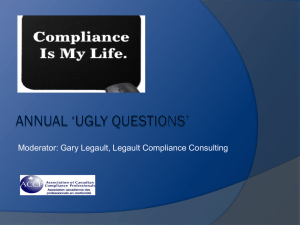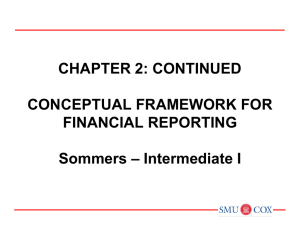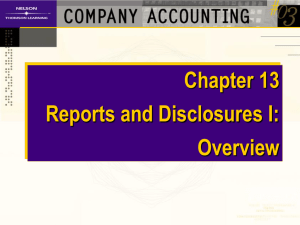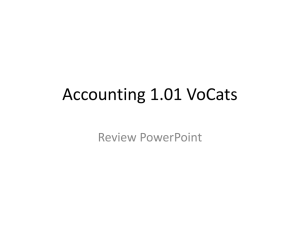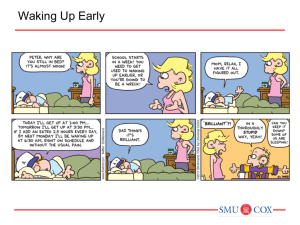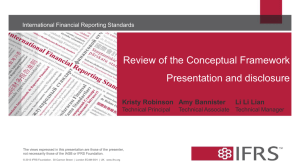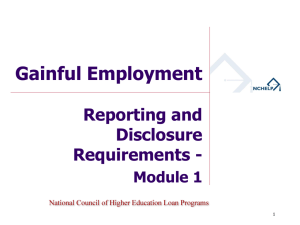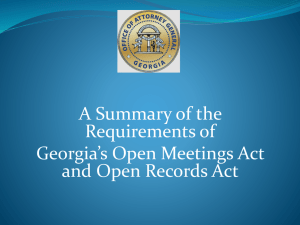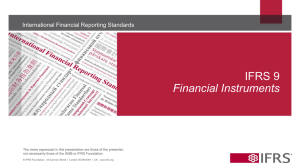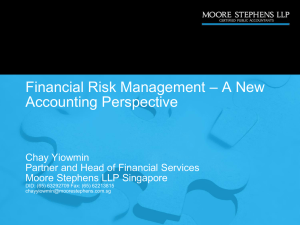IAS 1-BUppt
advertisement
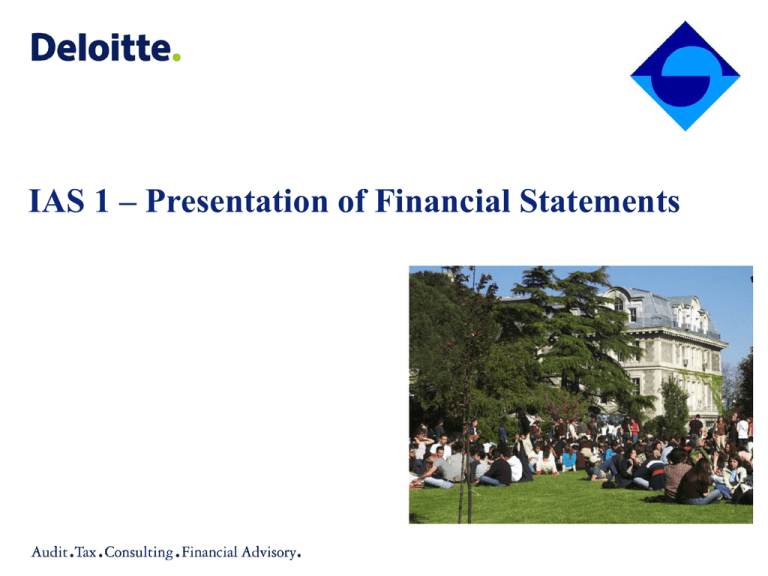
IAS 1 – Presentation of Financial Statements Agenda • Objective of the Standard • Components of Financial Statements • Fair Presentation under IFRS • Concepts of IAS 1 • Minimium Disclosure in a set of Financial Statements • Capital Disclosures Slide 1 Overview of the Standard • Objective of IAS 1 – Prescribes a basis for presenting general purpose financial statements that is is comparable and consistent – period over period – With the financial statements of other entities – Sets out underlying assumptions that govern the preparation of financial statements and – Stipulates minimum guidelines for financial statement structure and disclosure requirements. Slide 2 Overview of the Standard • Purpose of financial statements – Transparent information about entity’s: – Assets and liabilities – Equity – Income and expenses – Cash flows Slide 3 Components of Financial Statements • A complete set of financial statements include at a minimum the following components: – Balance sheet/Statement of Financial Position – Statement of Income – Statement of Comprehensive Income – Statement of changes in equity – Cash flow statement – Accounting policies and explanatory notes – Where there are reclassifications and adjustments to prior periods, the entity is required to disclose a Statement of Financial Position as at the beginning of the earliest comparative period. Slide 4 Components of Financial Statements • Question – An entity would like to issue a balance sheet and a statement of income only, it did not believe presentation of cashflows, shareholders’ equity and explanatory notes are necessary – is this correct? • Solution – A complete set of financial statement as required by IAS1 requires minimum disclosure that includes schedule on shareholders’ equity, cash flows as well as notes. • However, an entity may exclude presentation of a statement of cashflow if and only if it can prove that the information of cashflows is already appropriately disclosed in the other components of the financial statements. Disclosure of this is required in the notes to the financial statements. Slide 5 Fair Presentation under IFRS • Overriding premise in the preparation of financial information ----fair presentation of an entity’s cashflow and results of operations based on a consistent set of principles/guidelines. • Presumed that IFRS will result in fair presentation – With additional disclosure where necessary – Inappropriate accounting policies are not rectified by disclosure (An entity cannot adopt inappropriate accounting policies and just disclose that it is inappropriate in their note disclosures and assume this would mitigate the wrong accounting.) Slide 6 Fair Presentation of Financial Results • Fair as guided by: – The selection and application of consistent accounting policies in accordance with authoritative guidance under IFRS/IASB – Presentation of information, including accounting policies, in a manner that provides relevant, reliable, comparable and understandable information. – Providing additional disclosures when compliance with the specific requirements in IFRSs is insufficient to enable users to understand the impact of particular transactions, other events and conditions on the entity’s financial position and financial performance. • Departure from a specific guideline --- allowable if and only if application of IFRS would materially mispresent the substance of the transaction. Slide 7 Departure from IFRS – required disclosure • Explanation that the departure results in fair presentation • Compliance with IFRS, except for… – The standard or interpretation not complied with – Nature of the departure – What treatment would have been under IFRS – Why compliance would be misleading & conflict with IFRS obj. – The treatment adopted • Financial impact of the departure – Current year departure – Current year impact of prior year departure Slide 8 Basis Pillars of Financial Statement Presentation • Accrual Basis of Accounting • Going Concern Assumption • Materiality and Aggregation • Offsetting • Comparative Disclosure • Estimation Uncertainty • Management Judgement • Reclassifications of prior period comparatives Slide 9 Accrual Basis of Accounting • Financial information, other than cash flow statement is required to be presented on an accrual basis. • Revenue, expenses, assets and liabilities are recorded in the period where criteria for recognition and measurement is satisfied. Slide 10 Accrual Basis of Accounting - Example • Company A has a sales contract to sell 50 units of product A to Company B. At the end of August when it prepares it financial statements under IFRS, it only delivered 40 units to Company B. It had received the payment from Company B for all 50 units in advance. • Question – how much revenue can Company A recognize in its August financial statements? • Response – Company A can only recognize and measure revenue for 40 units that are sold and delivered to Company B. Although Company A has received the entire payment for 50 units, it had only delivered to Company B 40 units. It has not effectively earned the revenue for all 50 units. Slide 11 Going Concern • Key assumption in the preparation of financial statement. • An assessment is required to be made by management – Intention to liquidate or – No realistic alternative but to liquidate • Disclosure of uncertainties is required. • Disclosure of any other method used to prepare financial statements Slide 12 Going Concern – Example 1 • Company A experienced significant decrease in its sales this year. It has significant bank loans that are coming due and is concerned whether it can survive and also pay its loans. Company A’s owners are concerned about the economic situation but do not intent to close the business. • Question – does the going concern assumption apply to Company A’s financial statements? • Response – Yes, while Company A is not having a good business year, it has no intention to close and therefore the assumption that it will be continue to operate is valid. The financial statement of the Company will continue to be presented under that assumption. Depending on the seriousness of the business downturn, Company A may disclose this in its financial statements. Slide 13 Going Concern – Example 1 (cont’d) • If there is risk that GC is not appropriate, the Company (and the auditors) should assess: – Whether there are impariment indicators? – Whether assets should be written down to recoverable amount? – Whether provision is required for any unavoidable costs under onerous contracts ? – Whether debt now becomes due/current classification ? Slide 14 Going Concern – Management Assessment • Question – What types of information do management need to prepare as part of its assessment of going concern? • Response – the Company should review financial ratios/measures that indicate its ability to continue to operate in the next 12 months, at a minimum. This should generally include but is not limited to: – Review of the following12 months’ cash flow projection – Review of the Company’s sales/suppliers structure and payment requirements – Review of the Company’s debt positions and whether the Company will be liquid enough to meet its obligations THESE ASSESSMENTS SHOULD BE INITIATED BY MANAGEMENT. Slide 15 Offsetting • Balance sheet – Offsetting is never allowed, unless explicitly permitted by another Standard • Statement of Income – Offsetting is not allowed, unless: – Permitted by another Standard – Similar transactions, immaterial gains or losses Slide 16 Offsetting - Example • Example – Company A and B are unrelated parties, Company A has trading relationship with its suppliers, it then sells to Company B. Company B pays A for the supplies at the same cost to A. Can A net off the revenue from B and the cost it incurred with its suppliers? • Response - No, the practice of selling and buying at the same cost does not represent a contractual arrangement for reimbursement of costs of goods. Slide 17 Offsetting – Example • Example – Company A rents the property from the landlord who could not complete the property ready for renting out. Company A itself enters into a loan arrangement with a bank to finance construction of leasehold improvements (to get the property ready). The bank agreement does not make reference to the landlord. Company A has another agreement with its landlord where Company A can net of the amount of rental expenses with the lease payments. (effectively the landlord will pay for the finance costs to construct the leasehold improvements.) Can Company A net off its loan payments due to the bank with the amount it will recover from the landlord? • Response – NO, the Company has to present its obligations under the loan arrangement separate from the amount recoverable from the landlord. Slide 18 Consistency, Materiality and Aggregation • Consistency of presentation – Unless change is required by IAS, or significant change in operations require accounting change – presentation of F/S should be consistent period over period • Materiality and aggregation – Separate presentation of material items – Aggregation of immaterial amounts – Applies to both Balance Sheet and Statement of Income Slide 19 Other Concepts of IAS 1 Comparative Disclosures • F/S in compliance with IFRS are generally required to provide comparative balances and disclosures. • Unless it is explicitly permitted by IFRS, comparatives are required. Measurement Uncertainty/Management Estimate and Judgement • Assumption that there is inherent need for management estimation and judgement for certain items or transactions. • Disclosure of the types of estimates and critical judgement areas is a MUST in IAS 1 Slide 20 Disclosure in a Balance Sheet • Provide information that assists users in assessing liquidity/ solvency • Classification of assets & liabilities as current/ non-current – Based on conditions existing at balance sheet date – KEY: 12 months • Alternatively in order of liquidity – Only if this provides reliable & more relevant information Slide 21 Disclosure in Balance Sheet • Current assets – Expected to realized in normal course of operating cycle, – Held primarily for trading purposes, – Expected to be realized within 12 months, – Unrestricted cash or cash equivalents • Current liabilities – Expected to settle in normal course of operating cycle – Held primarily for trading purposes, – Due to be settled within 12 months, – Entity does not have unconditional right to defer Slide 22 Disclosure in Balance Sheet • Non-current assets and liabilities – All those not classified as current • Financial liabilities (FL) are current, if settlement within 12 months, even if: – original term > 12 months – intention to refinance on a long term basis – agreement to refinance after B/S date but before FS are issued • FL are current if breach of covenant and can be called – Because they become due on demand – Remains as non-current if waiver is received BY B/S date • Non-adjusting post-B/S events – Refinancing, rectifying breach after B/S date Slide 23 Disclosure in Balance Sheet - Example •Question – Company A’s year-end is December. In December 2012, it has total receivables from Company B in the amount of 500,000TL. Of this amount, one receivable of 200,000TL is due by the end of Feburary 2013. The rest relating to a long term sales arrangement is due in March 2014. Assuming all sales have been delivered. How should Company A present the receivables in its financial statements? •Response: Only 200,000TL would be a current receivables in the December year-end financial statement with the rest as long term receivable. Slide 24 Disclosure in Balance Sheet - Example •Question – The Company could not meet its loan covenants as at 31 December 2011. It also was not able to renegotiate the terms of the loan. The loan agreement states that in the event of covenant default, the loan is due immediately on demand. What should the Company consider when it is preparing the 2011 financial statements? •Response – Since the loan now becomes due on demand and it was not renegotiated or refinanced, the Company should reclassify the portion of the loan that was considered Long Term and reclassify it to ‘Current’. Slide 25 Minimum account line items in B/S • Cash and Cash equivalents • Trade and other receivables and payables • Biological assets • Inventories • Property, plant and equipment • Investment properties • Intangible assets • Financial assets & liabilities • Equity accounted investments • Trade and other payables • Provisions • Liabilities & assets for current tax • Deferred tax assets & liabilities • Minority interests, as part of equity • Issued capital & reserves Slide 26 Statement of Income • Revenue • Expenses (either by function or by nature) • Finance costs (separate from finance revenue – NO offsetting is allowed) • Share of the profit or loss of associates and joint ventures accounted for using the equity method; • Tax expense; • a single amount comprising the total of: – (i)the post-tax profit or loss of discontinued operations and – (ii)the post-tax gain or loss recognised on the measurement to fair value less costs to sell or on the disposal of the assets or disposal group(s) constituting the discontinued operation; • Profit or loss; • Each component of other comprehensive income classified by nature • Share of the other comprehensive income of associates and joint ventures accounted for using the equity method; and • Total comprehensive income Slide 27 Statement of Comprehensive Income • Requires non-owners type transactions to be presented as part of Other Comprehensive Income. • Examples include: changes in FX differences due to foreign operations, revaluation reserve, hedging differences, etc. • Companies have the option of presenting a single combined statement of income and comprehensive income = Statement of Total Comprehensive Income, or, • Presenting two separate statements – Statement of Income and a separate Statement of Comprehensive Income. • Disclosure of profit/loss and related EPS appropriated to owners and minority interests is required in both disclosure options Slide 28 Statement of Comprehensive Income – Single Format: Revenue 2012 2011 xxxx xxxx – Cost of sales Gross margin – Operating expenses (classification of expenses by profit function) Profit/(Loss) before tax – Income tax expense (recovery) PROFIT/LOSS for the year Other Comprehensive Income: (list items individually at net of tax amounts or at pre-tax balances with a separate line called ‘Income tax relating to components of other comprehensive income’ ) Other comprehensive income for the year, net of tax TOTAL COMPREHENSIVE INCOME Slide 29 Statement of Comprehensive Income – Single Statement Format: 2012 2011 Owners of the parent xxx xxx Minority Interest yyy yyy ZZZ ZZZ Owners of the parent xxx xxx Minority interest yyy yyy ZZZ ZZZ Profit attributable to: (related breakdown on EPS) Total Comprehensive Income attributed to: Slide 30 Statement of Comprehensive Income – two statements format: 2012 2011 Revenue – Cost of sales Gross margin – Operating expenses (classification of expenses by profit function) Profit/(Loss) before tax – Income tax expense (recovery) PROFIT/LOSS for the year Profit attributable to: Owners of the parent xxx xxx Minority Interest yyy yyy (related breakdown on EPS) Slide 31 Statement of Comprehensive Income – two statements format (cont’d) PROFIT/LOSS for the year 2012 2011 xxx xxx Other Comprehensive Income: (list items individually at net of tax amounts or at pre-tax balances with a separate line called ‘Income tax relating to components of other comprehensive income’ ) Other comprehensive income for the year, net of tax TOTAL COMPREHENSIVE INCOME ZZZ ZZZ Owners of the parent xxx xxx Minority interest yyy yyy ZZZ ZZZ Total Comprehensive Income attributed to: Slide 32 Statement of Changes in Owners’ Equity • Total Comprehensive Income • Capital transactions • Accumulated profit / loss at beginning and end of period • Reconciliation of share capital, premium and reserves Slide 33 Owner Changes in Equity and Statement of Comprehensive Income • All owner changes in equity to be reflected in a Statement of Changes in Equity and all non-owner changes in a Statement of Comprehensive Income (one statement or two statement format); • Examples of owner changes in equity: – Proceeds on issue of shares – Dividend payments to owners • Examples of non-owner changes in equity: – Revaluation surplus – Translation differences related to foreign operations – Gains or losses on AFS financial assets/cash flow hedges – Share of other comprehensive income of assocaites – Actuarial gains or losses on pension plans Slide 34 Other disclosures When the item is material, the following should be disclosed: • write-downs of inventories to net realisable value or of property, plant and equipment to recoverable amount, as well as reversals of such write-downs; • restructurings of the activities of an entity and reversals of any provisions for the costs of restructuring; • disposals of items of property, plant and equipment; • disposals of investments; • discontinued operations; • litigation settlements; and • other reversals of provisions. Slide 35 Note Disclosure – Statement of Compliance with IFRS – Basis of Accounting – Summary of Significant Accounting Policies – Supporting information for items presented in the face of the financial statements – Contingencies, commitment, guarantee. Slide 36 Capital Disclosures • An entity is required to disclose the following: – Its objectives, policies and processes for managing capital – Quantitative data about what the entity regards as capital – Whether the entity has complied with any capital requirements – If it has not complied, the consequences of such noncompliance Slide 37 Capital Disclosures - example The Group manages its capital to ensure that entities in the Group will be able to continue as a going concern while maximizing the return to stakeholders through the optimization of the debt and equity balance. The capital structure of the Group consists of debt, which includes the borrowings, cash and cash equivalents and equity attributable to equity holders of the parent, comprising issued capital and retained earnings. The Group’s board of directors reviews the capital structure regularly. As a part of this review, the board considers the cost of capital and the risks associated with each class of capital. Based on recommendations of the board, the Group will balance its overall capital structure through the payment of dividends, new share issues as well as the issue of new debt or the redemption of existing debt. Th e Company is required to meet certain financial covenants related to its loans, as disclosed in Note XXX Borrowings. For the year ended 31 December 2008, the Company has met its capital requirements per the loan covenants. Slide 38 Overview of the structure of the IFRS Foundation and IASB Slide 39 Kamu Gözetimi Muhasebe ve Denetim Standartları Kurumu QUESTIONS? Slide 40
